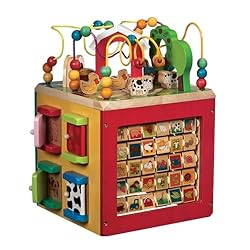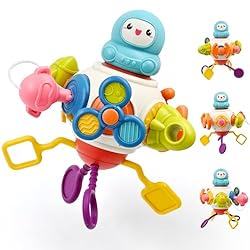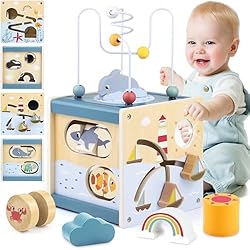Why Activity Cubes Are a Gift That Keeps Giving 🎁
When it comes to finding the perfect gift, activity cubes are a choice that ticks all the boxes. These interactive playsets are more than just toys—they’re mini-adventures packed into a cube, designed to entertain, educate, and engage all at once. Whether you’re shopping for a little one’s birthday, a festive celebration, or simply want to surprise a family with something thoughtful, an activity cube delivers endless smiles and learning opportunities.
What makes activity cubes such a standout gift? For starters, they’re brilliantly versatile. From sliding beads to spinning gears, these cubes offer a mix of activities that cater to different interests and developmental stages. They’re not just about keeping kids entertained; they’re about sparking curiosity, building fine motor skills, and encouraging independent play—all while looking delightfully fun.
Another reason to love activity cubes is their ability to grow with the child. Many are designed with multiple sides of activities, so as one skill is mastered, another awaits discovery. This makes them an excellent long-term option that continues to be engaging well beyond the initial unwrapping.
Whether you’re buying for a baby exploring their first sensory experiences or a toddler eager to learn new skills, an activity cube makes an impressive and thoughtful choice. With so many styles and features available, there’s a perfect cube out there for every child—and every budget. Let’s dive into why these magical little cubes deserve a place on your gift list.
What Makes a Great Activity Cube? 🧩
Features to Look For
When choosing an activity cube, several key features can make it a standout gift:
- Material: Wooden cubes often have a timeless charm and durability, while plastic ones are lighter and easier to clean. Consider the recipient's preferences and needs.
- Activities: Look for a variety of features like bead mazes, shape sorters, spinning gears, or clocks. A mix of activities keeps playtime engaging.
- Educational Elements: Many cubes incorporate numbers, letters, or colour recognition, which makes them ideal for combining fun with learning.
- Safety Features: Ensure the cube is free from sharp edges, uses non-toxic materials, and is age-appropriate.
- Size and Portability: Compact cubes are easy to store and travel with, while larger ones offer more extensive play options.
Age-Appropriate Choices
Activity cubes are designed for a range of ages, so selecting one that matches the child’s developmental stage is crucial:
- Babies (0–12 months): Simple cubes with large, safe elements and sensory features like textures or mirrors.
- Toddlers (1–3 years): Multi-activity cubes with challenges like sorting, stacking, and spinning parts.
- Preschoolers (3–5 years): Advanced options with clocks, numbers, and puzzles to stimulate critical thinking.
Activity Cubes vs. Other Toys: Why They Stand Out
- Versatility: While blocks and puzzles may focus on one skill, activity cubes combine multiple activities in one place.
- Longer Engagement: The variety of features keeps kids entertained for extended periods.
- Compact Fun: Unlike larger toys, activity cubes pack a range of entertainment into a space-saving design.
- Developmental Benefits: They promote fine motor skills, hand-eye coordination, and cognitive growth—all in a single package.
Creative Gifting Ideas for Activity Cubes 🎁
Personalised Presentation
- Wrap the cube in bright, playful paper and add a ribbon for a touch of charm.
- Include a card explaining why you chose this gift, emphasising its fun and educational benefits.
Pair It Up
Consider adding complementary items to create a memorable gift set:
- A storybook with matching themes (e.g., animals or shapes).
- Plush toys that tie into the cube's design.
- A play mat to make activity time more comfortable and fun.
Perfect for Group Gifting
Activity cubes can also be a shared gift for siblings or a family. Their multi-activity design ensures there's something for everyone.
Frequently Asked Questions About Activity Cubes
Are Wooden Activity Cubes Better Than Plastic Ones?
Wooden cubes often appeal for their durability and eco-friendly materials, while plastic cubes tend to be lighter and easier to clean. Both have their merits, so the choice depends on personal preference.
What Age Are Activity Cubes Suitable For?
Most activity cubes cater to children from 6 months to 5 years, with features tailored to different developmental stages. Always check the manufacturer’s guidelines.
Do Activity Cubes Require Batteries?
Most activity cubes are manual, focusing on hands-on play. However, some advanced models may include light or sound elements powered by batteries.
Are They Easy to Clean?
Yes! Wooden cubes can be wiped down with a damp cloth, while plastic cubes are typically dishwasher-safe for removable parts.
Can Activity Cubes Be Used for Sensory Play?
Absolutely. Many include features like textured surfaces, mirrors, and sound-making elements that are perfect for sensory exploration.
Creative Uses for Activity Cubes Beyond Playtime
- Decorative Keepsake: Once outgrown, an activity cube can become a charming display piece in a child’s room.
- Educational Tool: Use it in early learning environments for teaching colours, shapes, and basic motor skills.
- Recycling Fun: Repurpose old cubes by adding your own activities or painting them for a fresh look.
- Interactive Storytime: Use cube features to engage kids while reading themed books.
Building Memories, One Activity at a Time
Activity cubes aren’t just toys; they’re an invitation to explore, learn, and create lasting memories. By choosing one, you’re gifting a child endless opportunities for discovery and joy. Whether it’s their first bead maze or a cube full of puzzles, your thoughtful gift is sure to make an impression.
No matter which activity cube you pick, it’s a guaranteed hit that balances fun, education, and creativity in a single delightful package.
















